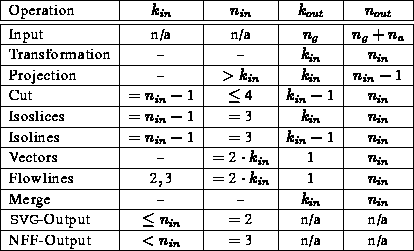 into an output
into an output  are characterized (by the relationships and
restrictions of the dimensions
of their respective input and output simplex sets) in
Table 5.2.
The input/output relationships are mostly implied by the abstract
operation that is performed, whereas input (or output)
limitations are mainly a matter of restricted implementation.
In
Table 5.2,
``n/a'' stands for not applicable, and a
dash ``-'' stands for no restriction.
are characterized (by the relationships and
restrictions of the dimensions
of their respective input and output simplex sets) in
Table 5.2.
The input/output relationships are mostly implied by the abstract
operation that is performed, whereas input (or output)
limitations are mainly a matter of restricted implementation.
In
Table 5.2,
``n/a'' stands for not applicable, and a
dash ``-'' stands for no restriction.






 is the spatial
dimension of the input geometry (or grid)
and
is the spatial
dimension of the input geometry (or grid)
and  is the dimension of the attribute defined on it.
is the dimension of the attribute defined on it.
 hyperplane.
hyperplane.
 (similar to orbitals).
(similar to orbitals).
 ).
).